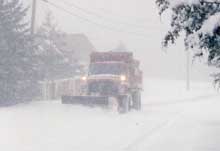The weather forecasters promised us a blizzard this past Sunday, and a
blizzard, of a sort, is what we got. “Blizzard” is defined as “a violent windstorm with dry, driving snow and intense cold.” The National Weather Service quantifies this as 35 mph winds and quarter mile visibility or less (there is no specific temperature requirement). Most people had hunkered down at home for the storm, so there was
little traffic nor need for frantic
snow plowing.
Although this was nothing like the Blizzard of 1888, the gold standard for storms in my youth when a few living folk could still remember it, or the Blizzard of 1978, which shut Connecticut down for three days, it was enough to jog my memories of snow removal. I grew up in northwestern Connecticut where it snows more seriously than in this southern corner of the state. Ordinary snow plowing was handled by dump trucks,
Chevys,
Dodges or
Internationals, for example, fitted with snow plows. Some towns had
Walter Snow Fighters, at least one of which was equipped with a
rotary wing plow.
For really serious snow drifts there was the
Klauer SnoGo, which had a front-mounted two- or three-bank auger ahead of a rotary blower. The thing consumed so much power that a
dedicated engine, mounted on the rear, was required to drive it. Klauer also built smaller SnoGos, for mounting on standard truck chassis. You can still buy a SnoGo; they’re now made by Wausau-Everest of New Berlin, Wisconsin.
My driveway measures some 240 feet from street to garage, too long for a geezer like me to shovel. My venerable
Gravely, about which you’ve read before, sprang to
action and had it
cleaned up in about two hours. One day I must re-activate the
Jeep left to me by my father. With a little work on the brakes, exhaust and generator, it would do much more than occupy a
corner of the garage.
By Monday morning, the
driveway and the
street were both clear, the sun was out and the temperature was rising. Life was back to normal, which includes not working on the Jeep.

